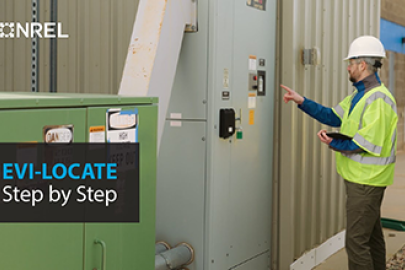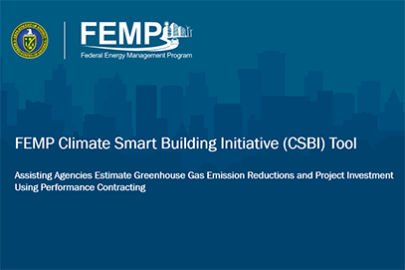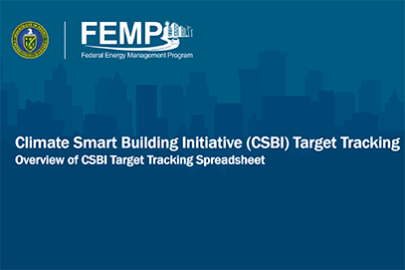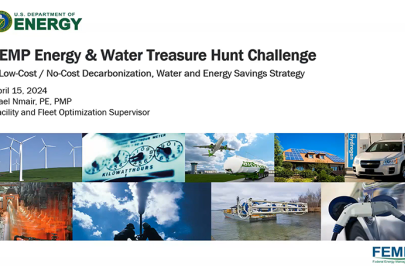This video features a success story from the Federal Energy Management Program’s Electric Vehicle Supply Equipment Tiger Team.
Federal Energy Management Program
September 9, 2022Narrator: The mission of the National Park Service is to preserve, unimpaired, the natural and cultural resources and values of the national park system for the environment, education, and inspiration of this and future generations. The Park Service cooperates with partners to extend these benefits of natural and cultural resource conservation and outdoor recreation throughout the country and the world. Through a long-standing partnership, the National Park Service and the Federal Energy Management Program - FEMP - have worked together to aid and further this mission throughout the years. Specifically in 2021, the Federal Energy Management Program and the National Park Service entered into a multi-pronged approach partnership. One of the prongs focuses on fleet electrification and Electric Vehicle Supply Equipment, EVSE planning. Sonia Smith-Pickle, Federal Fleet Program Manager, leads experts from FEMP and the National Renewable Energy Laboratory to conduct EVSE Tiger Team site assessments.
[Sonya Smith-Pickel, PMP, Federal Fleets Program Manager, Federal Energy Management Programs, U.S. Department of Energy]
Sonya Smith-Pickel: At FEMP we support the federal agencies with the three T's: tools, training, and tactical assistance. We love about our partnerships with NPS and others for technical assistance and Tiger Teams. It combines everything into one.
Narrator: The electrical engineers and ZEV experts in the FEMP Federal Fleet Program completed site assessments for multiple sites within the National Park System. Experts Jesse Bennett and Lydie Boyce of NREL analyzed the federal Zero Emission Vehicle Planning and Charging tool - ZPAC tool - specific to each site, the site's entire fleet. Using site-provided data and an in-house machine learning algorithm, they determine which vehicles in the fleet are optimal candidates for electrification including which ones would have the highest greenhouse gas emission reduction potential as well as modeled concerns for long range or low downtime vehicles. With site input, multiple parking locations are identified and prioritized, and experts work with sites to determine and presents a final report the site with professional opinions on EVSE deployment. Sites, in turn, are able to leverage this material to inform their leadership and their EVSE planning decisions.
The Golden Gate National Recreation Area was the first site to participate in FEMP's fiscal year 2022 EVSE Tiger Teams. The on the ground ZEV champion harnessed a dedicated team to provide vehicle, electrical, utility, and pertinent staff and visitor parking information to the ZEV experts in order to inform the assessment at Fort Cronkite and Fort Mason - two areas within the site. Due to the unique mission of the national park service this assessment looked at EVSE deployment options at historical sites for both government-owned vehicles and personally owned vehicles. For both federal and public charging, providing the site with modeled engineering data to inform their electrification efforts for their federal fleet, their employees, and their public visitors while supporting their mission at large.
Far away from the sunny shores of California, in the snowy mountains of Wyoming Grand Teton National Park began their EVSE Tiger Team site assessment January 2022. The Tiger Team evaluated capacity and load on the distribution transformer and main distribution panels at the Moose Campus and the grow venture campground to distinguish both quick and easy installation areas with capacity and future or intensive installation areas that would require upgrades. This approach complements Grand Teton's multi-phase charging stations approach based on their vehicle replacement cycles. The unique challenge that winter weather provides to the site cold, snow accumulation, and storage alteration of operations, and others made it an optimal candidate for an EVSE Tiger Team. Experts aided a remote site with winter conditions while they informed their whole of government EVSE planning tool with yet another diverse site to ensure the tool works well for the whole of government.
[Monta Baskerville, LEED AP BD+C, PPM, Energy Program Manager, Washington Area Support Office, National Park Service]
Monta Baskerville: Preservation of NPS with the FEMP Tiger Teams will help ensure an EVSE site assessment process that will meet the needs of NPS and will aid development of the strategic assessment of NPS sites to meet our fleet electrification goals. The diversity of NPS sites that have participated in the EVSE Tiger Team highlights a snapshot of the diversity of sites across the National Park Services portfolio. We look forward to using the whole of government EVSE planning tool that FEMP is developing on the rest of our sites.
Narrator: Learn more about Fleet Management, Fleet Electrification, and EVSE Tiger Teams at our website.
More Videos
-
 This Take Five training provides an overview of energy efficiency guidelines for food storage and equipment for federal employees and food-service contractors.
This Take Five training provides an overview of energy efficiency guidelines for food storage and equipment for federal employees and food-service contractors. -
 The free, online REopt platform is designed to help building owners, developers, utilities, researchers, and everyday citizens understand their optimal energy solution.
The free, online REopt platform is designed to help building owners, developers, utilities, researchers, and everyday citizens understand their optimal energy solution. -
 Learn how to use the Electric Vehicle Infrastructure – Locally Optimized Charging Assessment Tool and Estimator (EVI-LOCATE) web tool to guide you through the electric vehicle (EV) charging station planning process.
Learn how to use the Electric Vehicle Infrastructure – Locally Optimized Charging Assessment Tool and Estimator (EVI-LOCATE) web tool to guide you through the electric vehicle (EV) charging station planning process. -
 The Electric Vehicle Infrastructure – Locally Optimized Charging Assessment Tool and Estimator (EVI-LOCATE) website guides you through an interactive site assessment process and generates cost estimates and site layouts for EV charging projects.
The Electric Vehicle Infrastructure – Locally Optimized Charging Assessment Tool and Estimator (EVI-LOCATE) website guides you through an interactive site assessment process and generates cost estimates and site layouts for EV charging projects. -
 This webinar recording walks through the best practices for submitting an AFFECT application.
This webinar recording walks through the best practices for submitting an AFFECT application. -
 This video provides an overview of the Climate Smart Building Initiative (CSBI) Tool, including its purpose, how to use the tool, and other considerations. The speakers also provide a live demonstration of the tool.
This video provides an overview of the Climate Smart Building Initiative (CSBI) Tool, including its purpose, how to use the tool, and other considerations. The speakers also provide a live demonstration of the tool. -
 Webinar provides overview about Phase 2 of the Assisting Federal Facilities with Energy Conservation Technologies (AFFECT) Bipartisan Infrastructure Law (BIL) Federal Agency Call (FAC).
Webinar provides overview about Phase 2 of the Assisting Federal Facilities with Energy Conservation Technologies (AFFECT) Bipartisan Infrastructure Law (BIL) Federal Agency Call (FAC). -
 Video provides overview of the Climate Smart Building Initiative Target Tracker, an Excel-based workbook that sets agency emission reduction targets, and tracks projects and progress toward the agency targets.
Video provides overview of the Climate Smart Building Initiative Target Tracker, an Excel-based workbook that sets agency emission reduction targets, and tracks projects and progress toward the agency targets. -
 This informational webinar, hosted by the Federal Energy Management Program (FEMP), marks the launch of the 2024 FEMP Re-tuning Challenge.
This informational webinar, hosted by the Federal Energy Management Program (FEMP), marks the launch of the 2024 FEMP Re-tuning Challenge. -
 This webinar describes the foundational principles of the Federal Energy Management Program's (FEMP) Regional Energy and Water Treasure Hunt Program and helps agencies recognize no-cost, low-cost energy and water savings opportunities.
This webinar describes the foundational principles of the Federal Energy Management Program's (FEMP) Regional Energy and Water Treasure Hunt Program and helps agencies recognize no-cost, low-cost energy and water savings opportunities.

